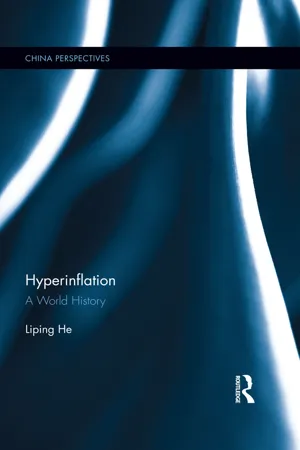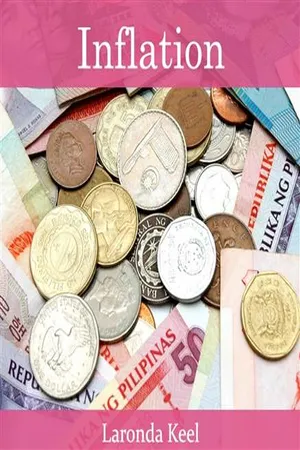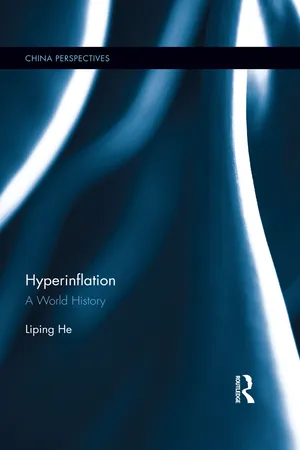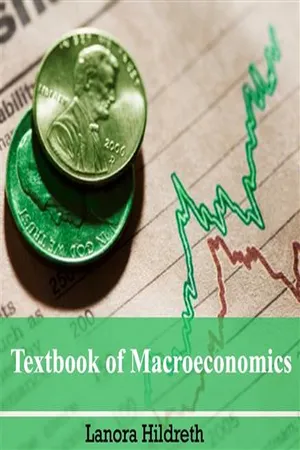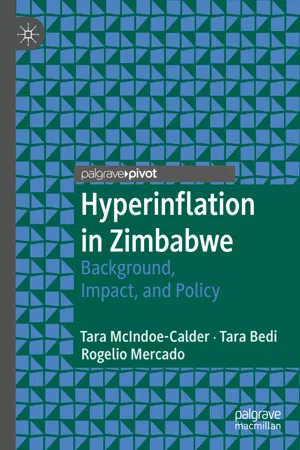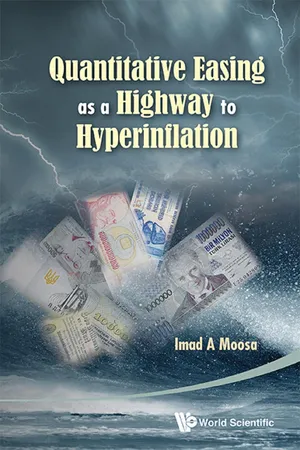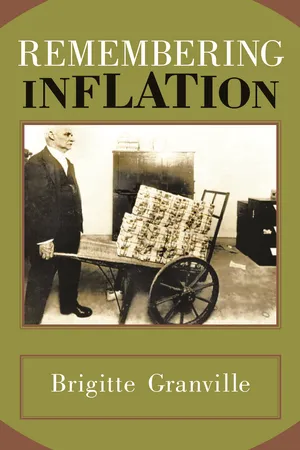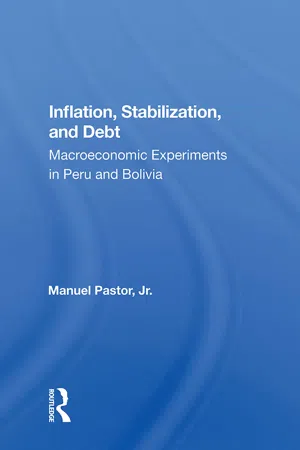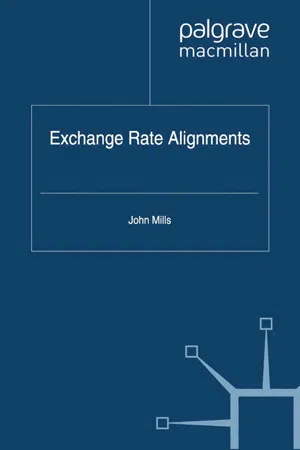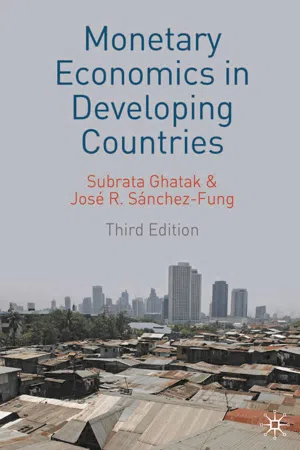Economics
Hyperinflation
Hyperinflation refers to an extremely rapid and out-of-control increase in the general price level of goods and services within an economy. This phenomenon typically occurs when the supply of money in circulation grows significantly faster than the available goods and services. Hyperinflation can lead to a loss of confidence in the currency, severe economic instability, and a sharp decline in the purchasing power of money.
Written by Perlego with AI-assistance
Related key terms
1 of 5
12 Key excerpts on "Hyperinflation"
- eBook - ePub
Hyperinflation
A World History
- He Liping(Author)
- 2017(Publication Date)
- Taylor & Francis(Publisher)
Introduction Basic concepts of Hyperinflation“Natura non facit saltum .” (Nature does nothing in jumps)An axiom cited by Alfred Marshall in his Principles of Economics , 1890“Nature abhors a vacuum.” AristotleInflation as an economic and monetary phenomenon usually refers to a rising trend in general prices in a country over a period of time. Hyperinflation is an unusual type of inflation wherein general price rises reach such unusually high levels that the currency tends to become no longer able to perform its normal functions in part or wholly. Monetary conditions in the economy have therefore rapidly become enormously aberrant. The causes of Hyperinflation may be easily confused with those of inflation, but they are distinctively different. As a type of financial crisis, Hyperinflation can lead to economic collapse, and a stabilization program is necessary following an outbreak of Hyperinflation. Correcting policy, building institutions in sensible ways, and having access to international resources are the most important elements of a successful stabilization program.What is Hyperinflation?
Inflation has been common worldwide from past to present, but Hyperinflation has not. Over the course of history, the known incidence of Hyperinflation is not high. From the late eighteenth century to the 2000s, 56 episodes of Hyperinflation involving nearly 40 countries or political regimes have been recorded, based on a “monthly” definition of Hyperinflation,1 and 16 countries have witnessed at least one Hyperinflationary incidence between 1800 and 2008,2 according to an “annual” definition of Hyperinflation.Three quantitative criteria of Hyperinflation
The first quantitative definition of Hyperinflation is that a general price level increases 50 percent or more from one month to the next. And, the second is that a general price level climbs at least 500 percent year on year. The two definitions of Hyperinflation are not directly comparable; there is no way to say which is greater. Of course, in a year when the monthly inflation rate is 50 percent every month, the annual inflation rate will be nearly 13,000 percent – corresponding to an almost 130-fold increase in prices – far greater than the annual criterion of 500 percent. In reality, however, hardly any country would see such an inflation rate sustained over a long period. In other words, an economy experiencing a monthly rate of 50 percent for one month or a few months may end up with an annual rate below 500 percent for the year. Or, an annual rate of 500 percent may be accompanied by a monthly rate of at least 50 percent for one or more months during that year. - No longer available |Learn more
- (Author)
- 2014(Publication Date)
- Orange Apple(Publisher)
____________________ WORLD TECHNOLOGIES ____________________ Chapter- 2 Hyperinflation Sweeping up the bank notes from the street after the Hungarian pengő was replaced in 1946 ____________________ WORLD TECHNOLOGIES ____________________ In economics, Hyperinflation is inflation that is very high or out of control. While the real values of the specific economic items generally stay the same in terms of relatively stable foreign currencies, in Hyperinflationary conditions the general price level within a specific economy increases rapidly as the functional or internal currency, as opposed to a foreign currency, loses its real value very quickly, normally at an accelerating rate. Definitions used vary from the International Accounting Standards Board's a cumulative inflation rate over three years approaching 100% (26% per annum compounded for three years in a row) to Cagan's (1956) inflation exceeding 50% a month. As a rule of thumb, normal monthly and annual low inflation and deflation are reported per month, while under Hyperinflation the general price level could rise by 5 or 10% or even much more every day. A vicious circle is created in which more and more inflation is created with each iteration of the ever increasing money printing cycle. Hyperinflation becomes visible when there is an unchecked increase in the money supply usually accompanied by a widespread unwillingness on the part of the local population to hold the Hyperinflationary money for more than the time needed to trade it for something non-monetary to avoid further loss of real value. Hyperinflation is often associated with wars (or their aftermath), currency meltdowns like in Zimbabwe, and political or social upheavals. Characteristics In 1956, Phillip Cagan wrote The Monetary Dynamics of Hyperinflation , generally regarded as the first serious study of Hyperinflation and its effects. In it, he defined Hyperinflation as a monthly inflation rate of at least 50%. - eBook - PDF
- He Liping(Author)
- 2017(Publication Date)
- Routledge(Publisher)
“ Natura non facit saltum .” (Nature does nothing in jumps) An axiom cited by Alfred Marshall in his Principles of Economics , 1890 “Nature abhors a vacuum.” Aristotle Inflation as an economic and monetary phenomenon usually refers to a rising trend in general prices in a country over a period of time. Hyperinflation is an unusual type of inflation wherein general price rises reach such unusually high levels that the currency tends to become no longer able to perform its normal functions in part or wholly. Monetary conditions in the economy have therefore rapidly become enormously aberrant. The causes of Hyperinflation may be easily confused with those of inflation, but they are distinctively different. As a type of financial crisis, Hyperinflation can lead to economic collapse, and a stabiliza-tion program is necessary following an outbreak of Hyperinflation. Correcting policy, building institutions in sensible ways, and having access to international resources are the most important elements of a successful stabilization program. What is Hyperinflation? Inflation has been common worldwide from past to present, but Hyperinflation has not. Over the course of history, the known incidence of Hyperinflation is not high. From the late eighteenth century to the 2000s, 56 episodes of hyperinfla-tion involving nearly 40 countries or political regimes have been recorded, based on a “monthly” definition of Hyperinflation, 1 and 16 countries have witnessed at least one Hyperinflationary incidence between 1800 and 2008, 2 according to an “annual” definition of Hyperinflation. Three quantitative criteria of Hyperinflation The first quantitative definition of Hyperinflation is that a general price level increases 50 percent or more from one month to the next. And, the second is that a 1 Introduction Basic concepts of Hyperinflation 2 Introduction general price level climbs at least 500 percent year on year. - No longer available |Learn more
- (Author)
- 2014(Publication Date)
- White Word Publications(Publisher)
____________________ WORLD TECHNOLOGIES ____________________ Chapter-7 Inflation In economics, inflation is a rise in the general level of prices of goods and services in an economy over a period of time. When the general price level rises, each unit of currency buys fewer goods and services. Consequently, inflation also reflects an erosion in the purchasing power of money – a loss of real value in the internal medium of exchange and unit of account in the economy. A chief measure of price inflation is the inflation rate, the annualized percentage change in a general price index (normally the Consumer Price Index) over time. Inflation's effects on an economy are various and can be simultaneously positive and negative. Negative effects of inflation include a decrease in the real value of money and other monetary items over time, uncertainty over future inflation may discourage investment and savings, and high inflation may lead to shortages of goods if consumers begin hoarding out of concern that prices will increase in the future. Positive effects include ensuring central banks can adjust nominal interest rates (intended to mitigate recessions), and encouraging investment in non-monetary capital projects. Economists generally agree that high rates of inflation and Hyperinflation are caused by an excessive growth of the money supply. Views on which factors determine low to moderate rates of inflation are more varied. Low or moderate inflation may be attributed to fluctuations in real demand for goods and services, or changes in available supplies such as during scarcities, as well as to growth in the money supply. However, the consensus view is that a long sustained period of inflation is caused by money supply growing faster than the rate of economic growth. Today, most mainstream economists favor a low, steady rate of inflation. - eBook - ePub
Hyperinflation in Zimbabwe
Background, Impact, and Policy
- Tara McIndoe-Calder, Tara Bedi, Rogelio Mercado(Authors)
- 2019(Publication Date)
- Palgrave Pivot(Publisher)
© The Author(s) 2019 T. McIndoe-Calder et al. Hyperinflation in Zimbabwe https://doi.org/10.1007/978-3-030-31015-8_4Begin Abstract4. Economics of Hyperinflation
Tara McIndoe-Calder1,Tara Bedi2andRogelio Mercado3(1) Central Bank of Ireland, Dublin, Ireland(2) Economics Department, Trinity College Dublin, Dublin, Ireland(3) The South East Asian Central Banks Research and Training Centre, Kuala Lumpur, MalaysiaAbstract
This chapter provides an overview of the conceptual and theoretical motivation behind the origins, mechanics and resolution of Hyperinflations. It relates various economic models into a framework that can be used to understand Hyperinflations. Finally, this chapter highlights the importance of inflationary expectations and seigniorage in the Hyperinflation process.End AbstractKeywords
Hyperinflation Money supply Money demand Adaptive expectations Rational expectations SeigniorageIntroduction
As stated in previous chapters, Hyperinflation describes a situation where the price level of goods and services increases very rapidly. As defined by Cagan (1956 ), Hyperinflation begins in the month where the increase in price levels exceeds 50 per cent a month and ends in the month before the monthly increase drops below 50 per cent. Empirically, there are episodes where inflation is thought to be very high, but not high or disruptive enough to be classified as Hyperinflations. Vegh (1992 ) terms these episodes “chronic inflation ”, where inflation is higher than in periods of moderate inflation, but much lower than in Hyperinflations. Moreover, chronic inflation tends to be more persistent, whereas Hyperinflations are rare occurrences. Hence, although Cagan’s (1956 ) definition of Hyperinflation is arbitrary, at 50 per cent, there is a clear demarcation between when inflation is chronic and when it becomes extremely severe. Hyperinflation differs from chronic inflation - eBook - PDF
- Davis W. Gregg, Dan M. McGill(Authors)
- 2016(Publication Date)
The institutions of the capital market provide the means by which the savings of some members of the community finance investments or the excessive consumption of others. But when the invest-ment or excessive consumption plans of the spenders exceed the savings plans of those who save, one or the other must change. If the money and banking system is willing to expand, the spending groups will have their way: the spenders will be financed, the money supply will rise, and prices and money incomes will rise suiEciendy to cause the savers to accumulate in money and other forms more than they had planned to save. The sum of consumption and investment will be made equal to the value of production by raising the money value of production with little or no increase in its real value. In mild inflations and following periods of deflation the real value of savings and investments may rise; in serious and long-continued inflations they probably will not. A rise in money and a rise in prices are * Assistant Director, Research and Statistics, International Monetary Fund. 109 n o World Insurance Trends essential parts of the process and we may therefore, with sufficient accuracy, define inflation as a rise of prices occasioned by an increase in the quantity of money. The family of words to which the bubble analogy has given rise includes deflation, reflation, disinflation, latent inflation, and Hyperinflation. The word Hyperinflation refers to a great rise in prices caused by a great in-crease in the quantity of money and a concomitant fall in the public's willingness to hold money. In inflation the value of a unit of money falls, that is to say, prices rise. In Hyperinflation the value of each unit falls to such an extent that the value of the whole stock of money falls, that is to say, prices rise enormously. The spenders are the producers of inflation ; the role of the savers is passive. - Imad A Moosa(Author)
- 2013(Publication Date)
- WSPC(Publisher)
Hyperinflation represents a traumatic experience that produces worthlessness. With reference to the German Hyperinflation, Ferguson (2008) points out that “not only was money rendered worthless; so too were all the forms of wealth and income fixed in terms of that money”. This makes one wonder why any rational government would engage in actions that cause or sustain Hyperinflation. One reason for such actions is that often the alternative to Hyperinflation is either a depression or a military defeat. Countries that go through this experience will in the aftermath enact policies to prevent its recurrence. This often means making the central bank very aggressive in accomplishing the objective of maintaining price stability, as was the case with the German Bundesbank, or adopting a currency board.The consequences of Hyperinflation are severe forms of the consequences of moderate inflation — all of those that were examined in Chapter 5 . We have seen, for example, that inflation causes an arbitrary redistribution of income from creditors to debtors. Therefore, a company with uncollected receivables will be put in a disadvantage, losing more and more the longer the receivables remain uncollected. In Fig. 6.10 , we see what happens to the value of receivables initially worth $100,000 at monthly inflation rates of 1% (moderate inflation) and 20% (Hyperinflation). The value of the receivables declines much more rapidly under Hyperinflation.Fig. 6.10.Erosion of receivables under inflation (simulated data).Hyperinflation is bad, actually destructive, for business planning (and hence, economic activity) — it is even bad for financial reporting. For example, the generally accepted accounting principles (GAAP) are poorly adapted to describe economic reality for firms operating under Hyperinflationary conditions. Traditional reporting systems produce large foreign exchange gains or losses that are difficult to interpret, mismatch revenues and expenses and overstate interest income and expenses. Under these conditions, financial statement users are provided with unreliable information for the evaluation of a business. Choi and Gunn (1997) propose a transaction-based reporting model to overcome many of these deficiencies. The model involves an examination of reported numbers in a disaggregated fashion, showing that with little additional effort conventional accounting data can be transformed into information that can be useful to a range of financial statement users. Whittington et al.- eBook - PDF
- Brigitte Granville(Author)
- 2013(Publication Date)
- Princeton University Press(Publisher)
When money was a commodity itself, such as gold, silver, or copper, discovery of new deposits led to inflation. The monetary coinage was often debased to finance spending when taxes proved insuffi-cient to finance wars, monuments, or other projects. Such has been the im-memorial practice of spendthrift rulers and regimes of all kinds and times. History has seen inflationary episodes occupying all points on a scale of magnitudes—from low to moderate, from high to very high (culminating in Hyperinflation), and lasting for a wide variety of periods. Although there are no hard-and-fast conventions on the definition of these different mag-nitudes, “very high inflation” is generally taken to mean an annual inflation rate above 100 percent. In the second half of the twentieth century, episodes of very high infla-tion were relatively frequent, as can be seen by the examples given in table 2.1. Such episodes in recent decades include Argentina, Bolivia, Brazil, Is-rael, Mexico, and Peru in the 1980s; former Soviet bloc countries such as Poland and Russia in the 1990s; and Zimbabwe in the first decade of the twenty-first century. The study of these episodes as well as others in the more distant past— France of 1795–96 (Sargent and Velde, 1995), Austria, Germany, Hun-gary, Poland, and Russia in the 1920s (Sargent, 1993)—underlay the latest O R I G I N S O F I N F L A T I O N 35 developments in understanding the origins of inflation. One of the most powerful and recurrent reasons for the frequency and intensity of high infla-tion is that governments need to generate revenue. Faced with inadequate tax revenues, governments can borrow either explicitly by issuing bonds or implicitly by expanding the monetary base. Until the second half of the twentieth century, most instances of large budget deficits and government Table 2.1 Episodes of very high inflation (above 100 percent annually). - eBook - PDF
- David Shapiro, Daniel MacDonald, Steven A. Greenlaw(Authors)
- 2022(Publication Date)
- Openstax(Publisher)
One of the reasons that the general public dislikes inflation is a sense that it makes economic rewards and penalties more arbitrary—and therefore likely to be perceived as unfair – even dangerous, as the next Clear It Up feature shows. Is there a connection between German Hyperinflation and Hitler’s rise to power? Germany suffered an intense Hyperinflation of its currency, the Mark, in the years after World War I, when the Weimar Republic in Germany resorted to printing money to pay its bills and the onset of the Great Depression created the social turmoil that Adolf Hitler was able to take advantage of in his rise to power. Shiller described the connection this way in a National Bureau of Economic Research 1996 Working Paper: A fact that is probably little known to young people today, even in Germany, is that the final collapse of the Mark in 1923, the time when the Mark’s inflation reached astronomical levels (inflation of 35,974.9% in November 1923 alone, for an annual rate that month of 4.69 × 10 28 %), came in the same month as did Hitler’s Beer Hall Putsch, his Nazi Party’s armed attempt to overthrow the German government. This failed putsch resulted in Hitler’s imprisonment, at which time he wrote his book Mein Kampf, setting forth an inspirational plan for Germany’s future, suggesting plans for world domination. . . . . . Most people in Germany today probably do not clearly remember these events; this lack of attention to it may be because its memory is blurred by the more dramatic events that succeeded it (the Nazi seizure of power and World War II). However, to someone living through these historical events in sequence . . . [the putsch] may have been remembered as vivid evidence of the potential effects of inflation. Blurred Price Signals Prices are the messengers in a market economy, conveying information about conditions of demand and supply. - eBook - PDF
Inflation, Stabilization, And Debt
Macroeconomic Experiments In Peru And Bolivia
- Manuel, Jr. Pastor, Manuel Pastor(Authors)
- 2019(Publication Date)
- Routledge(Publisher)
Analysis of these fundamental issues may seem irrelevant when pressed with the immediate task of ending what seems to be a monetary phenomenon, a hyper-inflation. But while Hyperinflations take place in the monetary sphere, their ulti-mate causes are found in the economic and political disintegration of the real sec-tor. The Bolivian experience seems to reflect such disintegration: On the one hand, external shocks to export revenues combined with the pressure of debt pay-ments to shrink GDP and damage public finance; on the other, distributional con-flict rooted in historic class tensions produced both a wage-price spiral and an in-ability to achieve a social consensus with regard to who should bear the costs of the fiscal adjustments required to close the public sector deficit. The New Economic Policy (NEP) attacked the inflation problems by adopting an orthodoxy that attracted new funds and shifted the burden of adjustment onto lower income groups. The proximate causes of inflation-exchange rate deterio-ration, large public deficits, and excessive monetary growth-received equal at-tention: The exchange rate was supported by dumping scarce reserves, borrowing abroad, and raising real interest rates to attract previous flight capital home; defi-cits were reduced by raising gasoline prices and then installing a new regressive tax system; and monetary growth was curtailed dramatically, triggering a liquid- 100 Bolivia: Hyperinflation and Stabilization ity crisis that weakened the domestic financial system and limited investment possibilities. The strategy ended the Hyperinflation but left a series of problems in its wake: an overvalued exchange rate, a significant trade deficit, high real inter-est rates, stagnant growth, weak private investment, dependence on short-term flight capital, and a regressive distribution of income that eventually provided the political ammunition for the ouster of the NEP's architects. - eBook - PDF
- J. Mills(Author)
- 2012(Publication Date)
- Palgrave Macmillan(Publisher)
3 The widely exhibited determination in the Western world to keep inflation down to very low levels is not, therefore, a sign of economic wisdom. It is much more convincingly seen as another sign of the 3 Inflation Inflation 41 dominance in the West of the culture and outlook of banking and finance over manufacturing and industry. Low inflation – and the high real interest rates which go with it – favours old money vis-à-vis new; lenders as against borrowers; established wealth holders as opposed to parvenus; and the already successful vis-à-vis their challengers. All these powerful groups, typically with deeply conservative instincts, have a vested interest in treating inflation as a major affliction. In fact, in moderation – at 4 to 5 per cent, to allow something of a safety margin against shocks which might push it up to more dangerous levels – it is nothing of the kind. On the contrary, it is an almost entirely unavoid- able but relatively harmless concomitant to any policies seriously orien- tated towards accelerating the growth rate and getting everyone back to work. A particularly strong link in the chain of inflationary demonology has been firmly established in the public mind – and in the academic and policy-orientated literature – in relation to any downward change in the exchange rate. Fear that devaluations automatically generate inflationary pressures in economies where they occur is widespread. A long-standing major tenet of the monetarist position is that any bene- fits secured from depreciation will at best be temporary. Price rises in the devaluing country will soon wipe them out, it is argued, and the economy concerned, after a short adjustment process, will be left no more competitive than it was before, save that it will have added an enhanced level of inflation. It is also widely believed that a devaluation necessarily produces a reduction in the living standards of an economy whose currency’s external value is falling. - eBook - PDF
- Subrata Ghatak, José R. Sánchez-Fung(Authors)
- 2017(Publication Date)
- Red Globe Press(Publisher)
It will be remembered that Willett and Logue (1976) found a statistically significant relationship between the level of inflation and its variability as measured by its standard deviation: high inflations are relatively unstable inflations. An important implication of this is that expectations regarding the inflation rate will frequently not be realized. This increases uncertainty ............................................... Money, inflation and growth 169 Table 9.1 Indonesia: government expenditure and revenue, 1960 prices (in billions of rupiahs) Expenditure Revenue Deficit Rate of inflation 1960 58 3 50 3 8 0 15 1 1961 64 0 45 0 19 0 39 3 1962 32 2 19 4 12 8 80 1 1963 38 4 18 9 19 5 88 9 1964 18 1 8 5 9 6 57 7 Sources : Hicks (1967); rate of inflation from Aghevli and Khan (1977). and will tend to reduce the willingness of people to engage in long-term contracts. The pattern of investment may therefore be distorted towards short-term projects, which may well yield lower social returns than long-term ones. It is a great mistake when analysing the effects of inflation to concentrate on possible effects on the level of investment to the exclusion of its composition (see, for example, Shaalan, 1962; Dorrance, 1963; Shaw, 1973; McKinnon, 1973 for discussion of this point). A further point is that at high and unstable rates of inflation, the efficiency of the price system as an indicator of desirable resource allocation is hindered. Not all prices adjust instantaneously to excess demand (this will be especially so in the case of public utilities, whose rates are often fixed for long periods of time, as is the foreign exchange rate), and therefore at any given time relative prices will be distorted by lags in adjustment in some sectors relative to others. This can be expected to produce adverse effects on the pattern of investment and resource allocation, thus reducing the overall efficiency of the economy.
Index pages curate the most relevant extracts from our library of academic textbooks. They’ve been created using an in-house natural language model (NLM), each adding context and meaning to key research topics.
